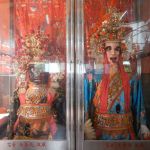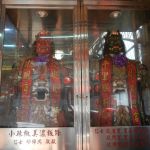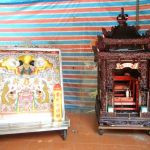
Lantern Festival. Photo by Elizabeth Phung. http://tinyurl.com/y9qdpfwn.
Share This
Print This
Email This
The Spring Festival: More American Than Asian
Once every year, people throughout East Asia crowd into buses, trains, boats, and airplanes in an annual mass migration to their ancestral hometowns. It’s the Spring Festival 春節 in the Chinese-speaking the world, the month of Tet in Vietnam, Seollal in Korea, and Tsagaan Sar in Mongolia, but it is always the same celebration—to mark the end of winter and the start of a new year. All businesses, banks, restaurants, stores, government offices, and schools close for the two-week festival. In Mainland China, Hong Kong, and Taiwan, there are no other major holidays, so for an entire culture of workaholics, two weeks off is indeed a cause for celebration. The Spring Festival can be compared to Thanksgiving, Christmas, New Year, and Easter compressed into one holiday.
The Spring Festival is a time of family reunion, feasting, and ritual. The holiday spans two weekends, and for most twenty-first-century married couples, one weekend might be spent with the husband’s parents and the other with the wife’s parents. Homes are filled with red banners, red posters, red lanterns, and red firecrackers. Images of gold, fish, flowers, and even playing children are everywhere—all auspicious symbols of prosperity. Diamond-shaped posters with the Chinese character for spring 春 and an inverted character for good fortune 福 announce the arrival of the new year and the hope for a propitious future. Posters of door guards are taped over entrances to gather good luck and chase away evil. Many Chinese and Taiwanese families follow traditional practices such as these to clear a path for good fortune to enter their lives. They build small private altars in front of their homes and businesses, complete with incense and offerings of food, and they will burn paper offerings as tribute to the gods. Since all the restaurants and stores are closed, the streets seem almost abandoned, but the temples are filled with worshipers. Shrines are surrounded by the smoke of incense and the prayers of the faithful, while the altars are covered with offerings of roasted meat, pastries, and drink. It is a time for feasting and celebration, even in Heaven.
Normally, worshipers go to the temples and seek the blessing of the gods. But on certain days, the gods leave the temples and give their blessing to worshipers in their neighborhoods. In South China, Hong Kong, Taiwan, Singapore, Malaysia, and beyond, one such day is the Lantern Festival 元宵節, the final day of the Spring Festival, when worshipers of the goddess Mazu 媽祖, the Holy Mother of Heaven 天上聖母, remove her idol from its shrine and carry her to the faithful. A powerful goddess like Mazu has many powerful servants, and they all join her procession as well. I saw one such Mazu temple procession behind my apartment during a study-abroad year in Taipei. Being a native of New Orleans, I naturally second-lined the procession for the next three hours. The procession began quietly with one person carrying a long stalk of bamboo with leaves. I have no idea what this bamboo stalk was for, but every temple and procession seemed to have one, so I will call it a “fengshui stick” for lack of a better term. This was followed by a color guard with banners bearing the name of the sponsoring temple and its temple association. Next came the first of many cohort of musicians, in this case, a pickup truck carrying drummers and cymbals. Next appeared a golden dragon, twisting and turning on the ground like a tornado, to begin the first assault against any demons in the area. The dragon stopped at one of the private altars that a small business had built, and the dragon danced around it while worshipers burned paper spirit money 金紙 before the altar.
The dragon departed and was followed by a float covered in flowers in the shape of a phoenix—not exactly traditional, but perhaps inspired by the Rose Bowl parades that Taiwanese migrants had seen in California. Next came another cohort of sign carriers with words of blessing, accompanied by woodwind players and more drummers. They preceded four guardian gods, who normally sit in silent guard at the entrance to the Mazu Temple, but here they were, standing like giants, marching, and towering over their entourage of musicians. As with the dragon, the guardian gods stopped and danced before the private altar, while the woodwinds played a dissonant and terrible song to instill terror in any demons present. Next came a dancing shrine, carried by four men and bearing the idol of another servant of Mazu, perhaps her personal assistant. The carriers spinned and rattled the shrine wildly in front of the private altar. Then at last arrived the shrine of Mazu herself, her idol clothed in the robes of a heavenly empress and carried in a luxurious sedan of silk and lacquered wood. Her arrival was signaled by incense, firecrackers, and yet more drums and cymbals and woodwinds. She gave her final blessing to the altar, while the owner of the altar, incense sticks in hand, gave a prayer of thanksgiving to Mazu.
- 媽祖信士 Mazu’s Ministers of Faith.
- 媽祖信士 Mazu’s Ministers of Faith.
- 台北安樂軒 Taipei Sedan of Peace and Happiness.
As I followed this procession, we passed under a pedestrian bridge, where worshipers had placed a battery of fireworks, and a brilliant fireworks display shot into the sky as we passed beneath. Processions from other nearby temples followed this first Mazu procession. One procession had a pair of dancing lions, who once again stopped and danced before the private altar. Another procession had a squad of five warrior gods, wearing colorful costumes, elaborate helmets, and face paint, and armed with different weapons. An entourage of horn players and gongs signaled their arrival, and the warrior spirits used their martial arts skill to battle invisible demons before the altar. There was even an American-style marching band, complete with a drum major with a twirling baton. They marched in formation and then formed into a circle in front of the altar, all while playing a march—perhaps something else Taiwanese migrants had seen in California.
However, the “Chinese New Year,” as it celebrated in the North America, bears only a superficial resemblance to the traditional Spring Festival as it exists in East Asia. For one thing, the Spring Festival is not a holiday in the United States. No traveling home. No family reunions. No break from studying—a lonely time for East Asian students in American schools. As it turns out, the opposite is true for Americans living in East Asia. Christmas is not celebrated there, and during my study-abroad year in Taipei, I remember spending the night before Christmas Eve studying for my midterm exams. I was so homesick while studying at 2 a.m. that I went to the McDonalds down the street and ordered a Big Mac value meal. I don’t even like McDonalds. And after our midterms, we had class on Christmas Day. Rather than the two-week holiday seen in East Asia, the American Spring Festival might be celebrated on the nearest weekend, when volunteers from the community are available.
In addition, the religious dimension of traditional festivals, including the Mid-Autumn Festival (sometimes called the “Moon Festival”) and the Duanwu Festival (sometimes called the “Dragonboat Festival”) are largely absent in North America. There are several reasons for this, but perhaps the most important reason is because dragon dances, lion dances, firecrackers, martial arts demonstrations, and everything else we associate with the Spring Festival are sponsored by temples and temple associations in East Asia, and sometimes by city government, like an American Fourth of July concert and fireworks display. But in the American South, traditional East Asian temples tend to be small and concentrated in a few major cities, such as Atlanta and Houston, where the East Asian population is quite large. Everywhere else in the South, traditional temples are quite rare. While these temples will also celebrate the Spring Festival, most American Spring Festival celebrations are sponsored by a local community association, business association, or even a Christian church.
Thus, an American Spring Festival celebration in not an expression of religious devotion, but a celebration of East Asian identity and culture. In Atlanta and Houston, the Spring Festival is like a community fair—celebrated for one or two days at the local Chinese community center. Elsewhere in the South, the Spring Festival might be a dinner and a show at a convention center or a hotel or a university or an East Asian church. And while the customs might be Asian, the celebration itself is very American. In San Francisco, New York, Washington D.C., and other cities with large East Asian populations, the community associations there sponsor a Spring Festival parade. I hear the San Francisco Chinese New Year parade is televised locally. But parading around your neighborhood because you are proud of your community is such an American thing to do, in a culture where many religious and ethnic groups live alongside each other. The Irish parade on St. Patrick’s Day, the Italians on St. Joseph’s Day, the Mexicans on the Feast of Our Lady of Guadalupe, and New Orleanians on Mardi Gras—because we’re French—or at least that’s what we tell people, since no one in France actually parades on Mardi Gras. I sincerely wish we had a Spring Festival parade in New Orleans—as we New Orleanians will use any excuse to have a parade—so perhaps one day . . .
Nonetheless, some elements of traditional religion do survive in this American Spring Festival. Even without sponsoring temples or large numbers of worshipers, smaller numbers of faithful continue to practice their religion, even in the American South. So the next time you see a dragon dance in Memphis or a Chinese martial arts display in Miami, take a closer look. Somewhere at those Spring Festival fairs in Atlanta and Houston, there might be a small shrine with incense and offerings of food. At your neighborhood Asian market or Asian mall, there might be a lion dance, with firecrackers and a burning pile of spirit money. It’s a smaller version of what you would see in China or Taiwan, but it will be there.
*All photos and video taken by the author.
Sources
Teiser, Stephen F., and Myron L. Cohen. “What Is Popular Religion.” Living in the Chinese Cosmos: Understanding Religion in Late-Imperial China. Asia for Educators. 2007. http://afe.easia.columbia.edu/cosmos/prb/whatis.htm.
Ho, Winston. 媽祖游行. Mazu Temple Procession, part 1 of 3. February 2012. https://www.youtube.com/watch?v=b95_ZM_hiLE.











It’s fun to know that an American Spring Festival celebration is a celebration of East Asian identity and culture rather than an act of religious piety. Speaking of, my friend is eager to attend a vibrant spring festival filled with music, cultural performances, and delicious food, as it promises a joyful and memorable experience. I, too, am excited to join in the festivities, as it presents an opportunity to immerse ourselves in the lively atmosphere, create lasting memories together, and celebrate the beauty of the season.